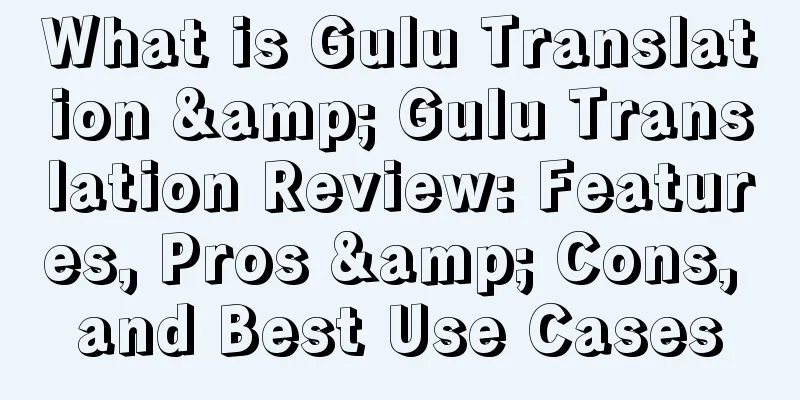What is Gulu Translation & Gulu Translation Review: Features, Pros & Cons, and Best Use Cases

|
Guangzhou Gulu Translation Co., Ltd. (referred to as "Gulu Translation") was established on May 26, 2018. It is committed to building a professional cross-border e-commerce translation platform. The platform follows the translation writing principles of "pure manual translation" + "e-commerce rules" + "data-based" to provide product translation and writing services for the majority of cross-border e-commerce sellers.
About Gulu Translation The Guru Translation Platform brings together translation talents in small languages from various countries and now has cross-border e-commerce language talents in more than a dozen languages including English, German, French, Spanish, Italian, and Japanese.
Service Content Our business covers listing writing and optimization for Amazon’s top ten sites (UK, US, Canada, Australia, Germany, France, Spain, Italy, Japan, and India). The customer provides simple and key product information, and the translator can write the product title, selling points, long description, ST search terms, and provide translator analysis.
Service Process Platform Features 1. Focus on vertical fields We focus on product translation and writing on cross-border e-commerce platforms, mainly writing and translating products for Amazon's global sites in different languages, and continue to open product translations for other major e-commerce platforms. 2. Disintermediation management Relying on Internet technology and business model changes, Gulu Translation connects users and translators directly, eliminating the communication barriers between users and translators in traditional translation companies, such as sales, delivery, and customer service. Customers fill in the basic information of the product and place an order on the Gulu Translation platform. The platform will match professional translators to write and translate. After successfully placing an order, customers can communicate directly with the translators to discuss the content of the manuscript, ensuring the effective transmission of user needs and ensuring the quality of the manuscript from the root. The de-intermediation model has also greatly reduced many operating costs of traditional translation companies. 3. Data-based translation All product writing and translation are not directly translated based on text, which is very different from traditional translation. Gulu Translation translators obtain the most cost-effective search term data based on the rules of e-commerce platforms, Internet search logic, market data analysis, and data research on competitor products, and combine the data with professional local languages to obtain a product translation result. 4. Accurate translator matching Gulu Translation has a powerful database analysis system. Before joining the Gulu Translation translator database, each translator needs to undergo multiple assessments including translation level, knowledge system, e-commerce platform rules, cross-border e-commerce experience, data analysis system software application, etc. After the translator enters the Gulu Translation translator database, the platform will also track and inspect him/her in multiple dimensions including order acceptance time, translation quality, service reputation, etc., to ensure that each translator completes the translation with high quality within the required time. 5. The translation process is visible and controllable When users place an order on the Gulu Translation online manual translation platform, they can clearly know the estimated delivery time; after placing an order, the translator will accept the order within 5 minutes at the fastest; after the translator accepts the order, the user can check the order progress at any time, and the project process is clear and direct. During the translation process, the user can communicate directly with the translator, put forward opinions and requirements, and control the overall progress of the project. 6. Quality assurance of translation manuscripts The platform has introduced reviewers with many years of experience in cross-border e-commerce platforms. After the translators complete the translation, the platform's professional quality department will conduct a second review. After the review is passed, the translation will be sent to the user. If the user has any objection to the translation, he or she can apply for a free return. 7. Super low price and simple calculation Unlike traditional translation, the price is not calculated by the number of characters, but based on a single product SKU. A SKU includes the title, search terms, description, selling points, etc. required by the platform; this greatly reduces the management and operating costs of cross-border e-commerce sellers. |
<<: What is Vcan & Vcan Review: Features, Pros & Cons, and Best Use Cases
Recommend
Price hike! Air freight prices in Europe and the United States continue to rise
Cross-border shipping prices have failed to incre...
US-based TryNow raises $12 million to enhance user experience
San Francisco-based TryNow said it has raised $12...
What is Printful? Printful Review, Features
Printful is a print-on-demand and fulfillment comp...
The total volume will exceed 100 billion pieces! China's express delivery industry performs well
With the rapid development of the domestic Intern...
Will American fashion make a comeback?
After a downturn during the epidemic, fashion app...
Good news for small and medium-sized businesses! "Ali Merchants Zero Distance" live broadcast reveals the secrets of the new intelligent manufacturing Rhino Factory
"What does Rhino Factory do?", "Wh...
What is Tuesday Morning? Tuesday Morning Review, Features
Tuesday Morning was founded in 1974 and is headqu...
Luxury e-commerce is booming, with Australia accounting for half of Azura's sales
Azura Consulting is an Australian technology-driv...
There may be a turnaround in shipping issues! China, the United States and Europe hold a maritime regulatory summit
Recently, supply chain problems have occurred fre...
The impact of Ramadan on online shopping habits of consumers revealed! Household products and other best-selling
Today, Ramadan has gradually evolved into an impo...
With a five-fold annual growth rate and revenue of $60 million, Bookshop.org is catching up with Amazon
According to foreign media reports, the online bo...
Another cross-border seller was arrested...
Counterfeit goods are rampant. Some sellers make ...
What is Yimaibao
Yimaibao is a cross-border e-commerce cloud servi...
Net profit soared, and suppliers made a fortune behind the huge sales of 3C products!
With the promising prospects of the 3C market, ma...
What is kat-vr? kat-vr Review, Features
kat-vr is an independent VR software and hardware ...









